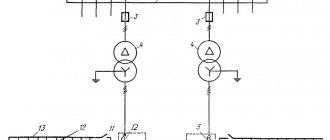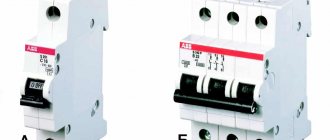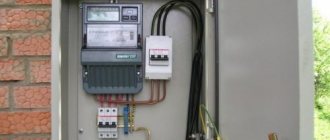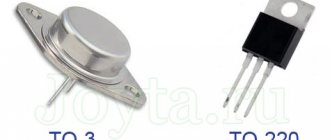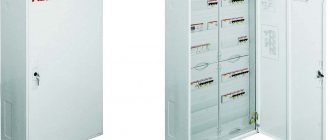Pneumatic type circuit breaker
This type of switches is such a circuit breaker that operates in air at atmospheric pressure. After the development of oil circuit breaker, medium voltage circuit breaker (ACB) is completely replaced by oil circuit breaker in different countries. But in countries like France and Italy, ACB is still the preferred choice for voltages up to 15 kV. It is also a good choice to avoid the risk of oil fire in case of oil breaker. In America, ACBs were used exclusively for systems up to 15 kV until the development of new vacuum and SF6 circuit breakers.
Advantages and disadvantages
Features of the application and design of limit switches
The advantages of such outdated devices are few, here are the main ones:
- Due to long-standing use, there is extensive experience in both operation and repair;
- Unlike other more modern counterparts (especially SF6), these switches can be repaired.
Among the shortcomings I would like to highlight the following:
- Availability of additional pneumatic equipment or compressors for operation;
- Increased noise during shutdown, especially during emergency short circuit conditions;
- Large, out-of-date dimensions, which causes an increase in the territory allocated for outdoor switchgear;
- They are afraid of humid air and dust. Therefore, additional measures are taken for air systems; equipment aimed at reducing these harmful factors is installed.
Operating principle of air circuit breaker
The operating principle of this switch is very different from any other type of switch. The main purpose of all types of circuit breaker is to prevent arc restoration after zero current by creating a situation where the contact gap will withstand the system restoration voltage. The air circuit breaker works in the same way, but in different ways. To interrupt the arc, it creates an arc voltage higher than the supply voltage. Arc voltage is defined as the minimum voltage required to maintain an arc.
This circuit breaker increases the arc voltage primarily in three different ways:
- This can increase the arc voltage by cooling the arc plasma. As the temperature of the arc plasma decreases, the mobility of the particle in the arc plasma decreases; therefore, more voltage gradient is required to maintain the arc.
- This can increase the arc voltage by lengthening the arc. As the length of the arc path increases, the resistance of the path increases and therefore, to maintain the same arc current, additional voltage is required to flow along the arc path. This means that the arc voltage increases. Dividing the arc into a number of successive arcs also increases the arc voltage.
ACB operation
The first goal is usually achieved by making the arc contact the largest possible area of the insulating material.
Each air circuit breaker is equipped with a chamber surrounding the contact. This chamber is called an "arc chute". The arc is brought into it. If the inside of the arc trough is shaped appropriately, and if the arc can be made to fit the shape, the arc trough wall will help achieve cooling. This type of arc extinguisher must be made of some kind of fire-resistant material. High temperature glass reinforced plastics and ceramics are the materials of choice for arc trough construction. The second goal, which lengthens the arc path, is achieved simultaneously with the sight. If the inner walls of the arc groove are formed in such a way that the arc is not only forced towards it, but is also driven into a serpentine channel projected onto the wall of the arc groove. Lengthening the arc path increases the arc resistance. The third method is achieved by using a metal arc cut inside the arc groove. The main arc trough is divided into a number of small compartments using metal dividing plates. These metal divider plates are actually arc splitters, and each of the small compartments behaves like a separate mini arc chute. In this system, the initial arc is broken down into a number of successive arcs, each of which will have its own mini-arc groove. Thus, each of the split arcs has its own cooling and elongation effect due to its own mini-arc groove, and hence the individual voltage on the split arc becomes high. Together they create a total arc voltage that is much greater than the system voltage.
This was the working principle of the air circuit breaker, now we will discuss in detail the working of ACB in practice. An air circuit breaker operating at 1 kV voltage level does not require any arc control device. Mainly for heavy short circuit currents at low voltage (low voltage level above 1 kV) ABC with appropriate arc control device is a good choice. Typically these switches have two pairs of contacts. The main pair of contacts carries current under normal load, and these contacts are made of copper. The additional pair is an arcing contact and is made of carbon. When the breaker is open, the main contacts open first, and when the main contacts open, the arcing contacts are still in contact with each other. As current flows in a parallel low resistive path through the arcing contact, there will be no arc at the main contact when the main contacts open. The acoustics only begin when the arc contacts are finally released. Each of the arc contacts is equipped with an arc arrester that helps the arc move upward due to both thermal and electromagnetic effects, as shown in the figure. As the arc moves upward, it enters an arc trough consisting of splitters. The arc in the tray will become colder, lengthen and break, so the arc voltage becomes much greater than the system voltage during operation of the air circuit breaker, and therefore the arc finally goes out during zero current.
Although these types of circuit breakers have become obsolete for medium voltage applications, they are still preferred for high power ratings at low voltages.
Automatic air blast switch
These types of air circuit breakers were used for system voltages of 245 kV, 420 kV and even higher, especially where faster circuit breaker operation was required. The air air circuit breaker has certain advantages over the oil circuit breaker, which are listed below:
- There is no danger of fire caused by oil.
- The opening speed of the circuit breaker is much higher during the operation of the air blast circuit breaker.
- Arc extinguishing is much faster while the air blast circuit breaker is operating.
- The arc duration is the same for all values of small and large current interruptions.
- Since the arc duration is shorter, therefore less heat is realized from the arc to the live contacts, hence the service life of the contacts is increased.
- The stability of the system can be well maintained as it depends on the operating speed of the circuit breaker.
- Much less maintenance is required compared to an oil circuit breaker.
There are also some disadvantages of pneumatic breakers
- To have frequent operations, it is necessary to have a large enough air compressor.
- Continuous maintenance of the compressor, associated air pipes and automatic control equipment is also required.
- Due to the high-speed current interruption, there is always the possibility of a high rate of rise of the re-strike voltage and current grinding.
- There is also the possibility of air leaks from the ducts.
As we said earlier, there are mainly two types of ACB, simple air circuit breaker and air circuit breaker.
But, the later part can be divided into three categories.
- Axial Blast ACB.
- Axial explosion ACB with lateral moving contact.
- Cross Blast ACB.
Axial air circuit breaker
In axial blast ACB, the moving contact is kept in contact with the stationary contact using spring pressure as shown in the figure. The fixed contact has a nozzle hole that is blocked by the tip of the moving contact when the switch is in the normal closed state. When a fault occurs, high pressure air is introduced into the arc chamber. The air pressure will oppose the spring pressure and deform the spring, so the moving contact is removed from the stationary contact and the nozzle hole becomes open. At the same time, high pressure air begins to flow in an arc through the fixed contact nozzle opening. This axial flow of air in an arc through the nozzle opening will cause the arc to become longer and colder, so the arc voltage becomes much higher than the system voltage, which means the system voltage is not enough to maintain the arc, so the arc is extinguished.
Magnetic splitter
The mechanism of action of the magnetic device is driven by a movable core. A splitter of this type is a solenoid, through the winding of which the current flowing through the switch passes; when the rated value is exceeded, the core begins to retract. The magnetic type has the property of instantaneous operation, which the thermal type cannot boast of, but the reaction occurs only if the set threshold is significantly exceeded. Several varieties are used that have varying degrees of sensitivity.
READ MORE: Sewerage installation in a private house - diagrams, design stages of work
During the splitting process, there is a possibility of an electric arc. To prevent this, an arc extinguishing grid is placed next to the contacts, and the elements themselves are made in a special shape.
Automatic cross blast switch
The operating principle of a cross air flow circuit breaker is quite simple. In this air jet switch system, the jet pipe is fixed perpendicular to the movement of the moving contact in the arc room, and on the opposite side of the arc chamber, one exhaust chamber is also installed with the same alignment of the jet pipe, so that the air coming from the jet pipe can directly flow into the exhaust chamber through the contact gap of the switch. The exhaust chamber is flattened by arc splitters. When the moving contact is removed from the stationary contact, an arc is established between the contact and at the same time, high pressure air coming from the blast tube will pass through the contact gap and will be forced to blow into the exhaust chamber, where the arc is divided by arc splitters and, in Ultimately, the arc hardens.
Device classification
Features of the use of remote control switches
All air high-voltage switches, except for their design (with and without separator), also differ in purpose:
- Network. They are designed for voltages of 6000 volts and higher and are used in alternating current circuits to turn consumers on and off in normal non-emergency operating modes, as well as shutdown in the event of short circuits;
- Generating. They are used in networks with operating voltages from 6 to 24 thousand Volts, for connecting generators to these circuits. Withstands starting currents, as well as short-circuit modes;
- For electrothermal installations. The operating voltage at which normal switching is possible is 6–220 kV. Can also work in emergency modes.
- Special purpose. They are not mass-produced, but made to order and manufactured taking into account local operating conditions.
And also switches that have a pneumatic installation for operation are divided according to the type and location of this mechanism that pumps air into the device:
- Support;
- Hanging. They have a structure suspended from the portal installed on the outdoor switchgear;
- Roll-out. Equipped with a mechanism for rolling out of the switchgear;
- Built into switchgear (complete switchgear).
